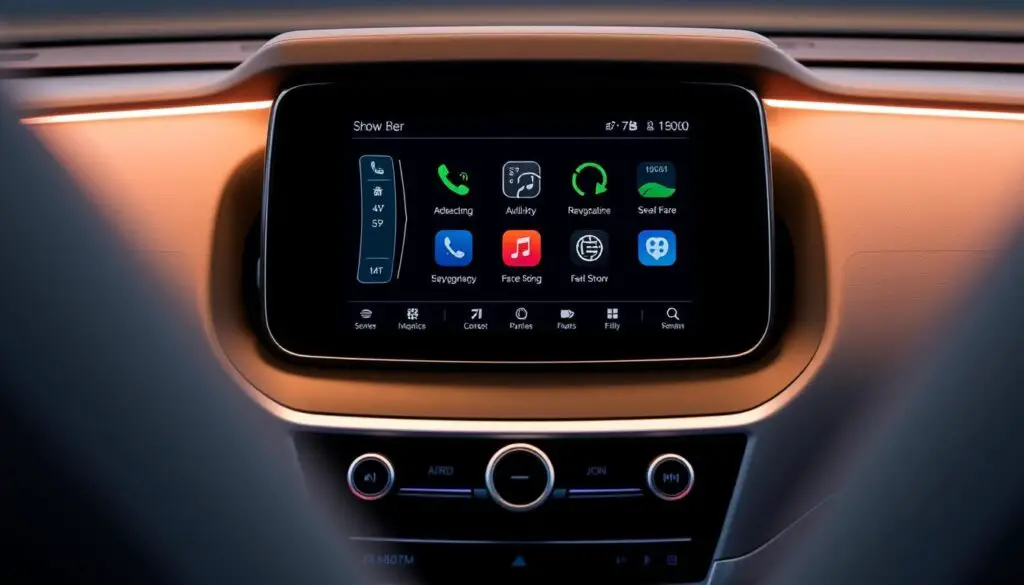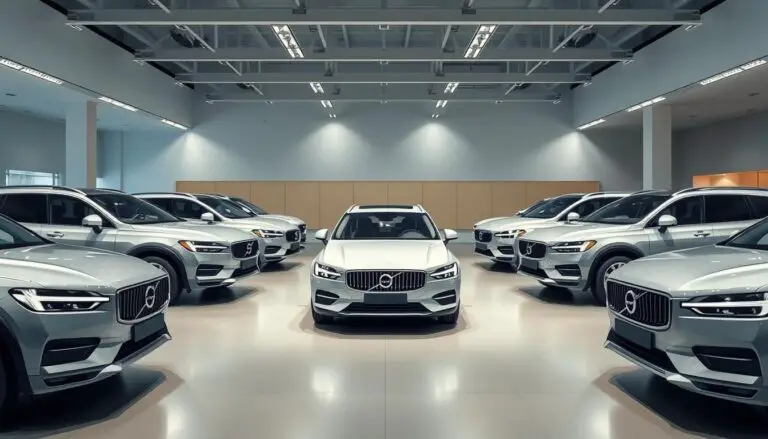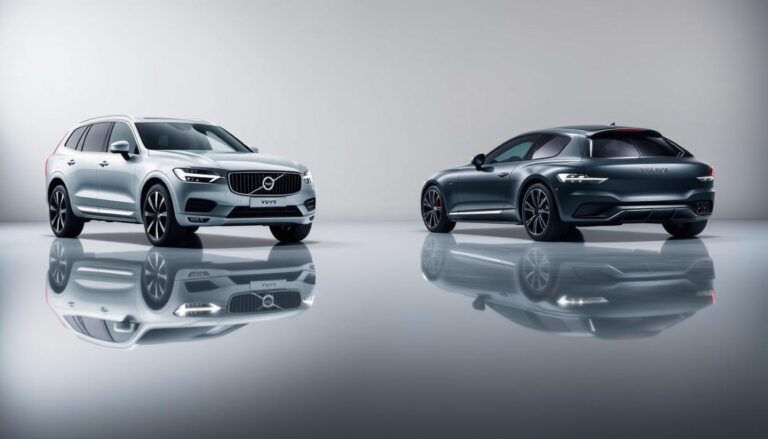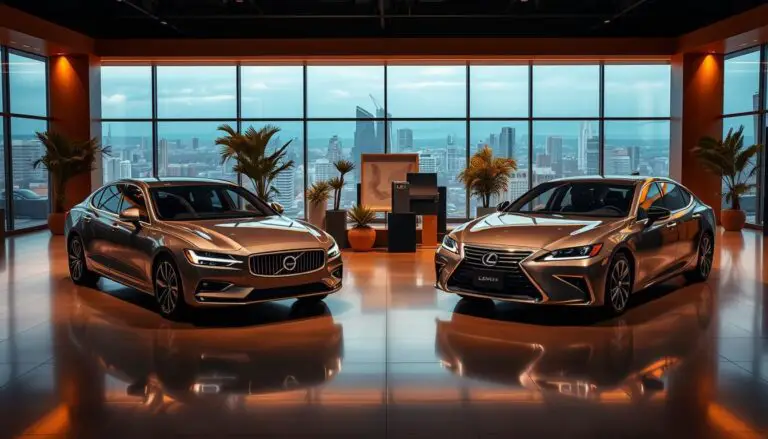When it comes to luxury cars, two brands stand out: Volvo and Infiniti. Both manufacturers have a rich history and distinct philosophies that set them apart in the automotive world.
The debate between these luxury car brands centers around their performance, features, and overall value. As we delve into this comparison, we’ll explore what makes each brand unique and which one might be the best fit for your needs.
Key Takeaways
- Overview of Volvo and Infiniti’s histories and philosophies
- Comparison of performance and features
- Analysis of overall value and luxury experience
- Insights into the unique selling points of each brand
- Guidance on choosing the right luxury car brand for you
The Legacy of Luxury: Brand Histories Compared
Volvo and Infiniti, two prominent luxury car brands, have distinct histories that shape their vehicles today. Understanding their backgrounds can provide valuable insights into their design philosophies, engineering priorities, and brand identities.
Volvo’s Scandinavian Heritage
Volvo’s history is deeply rooted in Scandinavian culture and values, emphasizing safety, durability, and functionality. Founded in 1927 in Gothenburg, Sweden, Volvo has consistently prioritized innovation and quality. The brand’s commitment to safety has led to numerous pioneering achievements, including the introduction of the three-point seatbelt.
Scandinavian design principles have significantly influenced Volvo’s aesthetic, characterized by minimalism, clean lines, and a focus on functionality. This heritage continues to shape Volvo’s luxury vehicles, blending form and function seamlessly.
Infiniti’s Japanese Luxury Roots
Infiniti, launched in 1989, is the luxury division of Nissan, drawing on Japan’s rich automotive history and cultural nuances. Infiniti’s origins are tied to Nissan’s quest to create a premium brand that embodies Japanese craftsmanship and attention to detail. The brand is known for its performance, comfort, and advanced technology.
Japanese luxury is about precision, elegance, and a deep understanding of customer needs. Infiniti’s vehicles reflect these values, offering a blend of dynamic performance, sophisticated design, and innovative features that cater to the discerning luxury car buyer.
Design Philosophy: Scandinavian Minimalism vs Japanese Elegance
In the luxury automotive sector, design philosophy is a key differentiator between brands like Volvo and Infiniti. This distinction is not just about aesthetics; it reflects the brand’s heritage, values, and approach to innovation.
The design languages employed by these luxury brands appeal to different consumer preferences, shaped by cultural and regional influences. Let’s delve into the specifics of each brand’s design philosophy.
Volvo’s Clean, Functional Aesthetics
Volvo’s design philosophy is deeply rooted in Scandinavian minimalism, emphasizing clean lines, functionality, and simplicity. This approach is evident in models like the 2024 Volvo XC60, where every element serves a purpose, and unnecessary embellishments are avoided.
- Key Features:
- Clean and simple design
- Functional elements
- Emphasis on safety and usability
This design philosophy not only reflects Volvo’s Swedish heritage but also appeals to consumers who value understated elegance and practicality.
Infiniti’s Flowing, Dynamic Styling
In contrast, Infiniti’s design philosophy is characterized by flowing, dynamic styling, inspired by Japanese luxury design principles. Infiniti’s models, such as the QX50, showcase a more fluid and aerodynamic approach, with sleek lines and a premium feel.
- Key Features:
- Flowing and dynamic lines
- Aerodynamic design
- Premium materials and finishes
Infiniti’s design language is designed to evoke a sense of dynamism and luxury, appealing to consumers who appreciate a more elaborate and sophisticated aesthetic.
Volvo vs Infiniti: Performance Comparison
In the realm of luxury vehicles, performance is a key differentiator, and Volvo and Infiniti showcase this in different ways. The performance comparison between these two luxury brands involves examining their engine options, power delivery, handling, and fuel efficiency.
Engine Options and Power Delivery
Both Volvo and Infiniti offer a range of engine options that cater to different performance needs.
Volvo’s Turbocharged and Hybrid Powertrains
Volvo’s approach to performance includes turbocharged and hybrid powertrains. Their engines are designed to provide a balance between power and efficiency. For instance, the Volvo XC90 offers a turbocharged and supercharged inline-4 engine that produces 316 horsepower. Additionally, Volvo’s hybrid models, such as the XC90 T8, offer an electric motor combined with a turbocharged and supercharged engine, resulting in a total system output of 400 horsepower.
Infiniti’s V6 and Variable Compression Engines
Infiniti, on the other hand, focuses on V6 engines and variable compression technology. The Infiniti QX60 is equipped with a 3.5-liter V6 engine that delivers 295 horsepower. Infiniti’s variable compression engine, found in models like the Q50, adjusts the compression ratio to optimize both power and efficiency, showcasing Infiniti’s innovative approach to engine technology.
Handling and Driving Dynamics
The handling and driving dynamics of Volvo and Infiniti vehicles differ significantly due to their distinct design philosophies. Volvo is known for its emphasis on stability and control, with features like all-wheel drive being standard across most models. Infiniti, while also offering all-wheel drive, focuses on a more dynamic driving experience, with models like the Q50 featuring Direct Adaptive Steering.
| Brand | Model | Engine Type | Horsepower |
|---|---|---|---|
| Volvo | XC90 | Turbocharged Inline-4 | 316 |
| Volvo | XC90 T8 | Hybrid | 400 |
| Infiniti | QX60 | V6 | 295 |
| Infiniti | Q50 | Variable Compression | 406 |
For a more detailed comparison of specific models, you can visit this page, which provides an in-depth analysis of the 2025 Infiniti QX60 Autograph and the Volvo XC90 Ultra.
Fuel Efficiency Comparison
Fuel efficiency is another critical aspect of performance. Volvo’s hybrid models generally offer superior fuel economy, with the XC90 T8 achieving an estimated 24 MPG combined. Infiniti’s V6 engines, while powerful, typically offer slightly lower fuel economy, with the QX60 achieving around 22 MPG combined.
Safety Features and Innovations
When it comes to luxury vehicles, safety is a top priority, and both Volvo and Infiniti have made significant strides in this area. The emphasis on safety has led to the development of advanced technologies designed to protect drivers, passengers, and pedestrians alike.
Volvo’s Safety Legacy and Current Technologies
Volvo has long been renowned for its commitment to safety, pioneering numerous innovations that have become standard in the industry. Two of its most notable safety features are City Safety and Pilot Assist.
City Safety and Pilot Assist Systems
City Safety is an automatic collision avoidance system that can detect potential collisions and apply the brakes if necessary. Pilot Assist takes this a step further by combining adaptive cruise control with semi-autonomous steering capabilities, enhancing both safety and convenience on long journeys.
Crash Test Ratings and Structural Design
Volvo’s vehicles consistently achieve high ratings in crash tests, thanks in part to their robust structural design. The use of high-strength steel and advanced airbag systems contributes to their excellent safety record.
Infiniti’s Safety Systems and Ratings
Infiniti has also made significant investments in safety, with features like ProPILOT Assist and Safety Shield360 designed to provide comprehensive protection.
ProPILOT Assist and Safety Shield360
ProPILOT Assist is a semi-autonomous driving system that can steer, accelerate, and brake in certain conditions, reducing driver fatigue on long trips. Safety Shield360 encompasses a suite of safety features, including automatic emergency braking, blind-spot warning, and lane-departure warning, to provide 360-degree protection.
Crash Prevention Technologies
Infiniti’s crash prevention technologies are designed to anticipate and react to potential hazards, further enhancing safety on the road.
| Safety Feature | Volvo | Infiniti |
|---|---|---|
| Automatic Emergency Braking | City Safety | Safety Shield360 |
| Semi-Autonomous Driving | Pilot Assist | ProPILOT Assist |
| Lane Departure Warning | Yes | Yes |
Interior Comfort and Luxury Appointments
The cabin of a luxury car is a sanctuary of comfort and refinement. Both Volvo and Infiniti have focused on creating interiors that exude luxury and provide a comfortable driving experience.
Cabin Design and Materials
Volvo is renowned for its Scandinavian design philosophy, which emphasizes clean lines, minimalism, and the use of premium materials. The interiors of Volvo cars are characterized by their simplicity and elegance, often featuring high-quality woods and leather upholstery. In contrast, Infiniti’s cabin design is more elaborate, with flowing lines and a mix of materials that create a sense of dynamism and luxury. Infiniti’s use of premium leather, wood trim, and metallic accents contributes to a rich and sophisticated ambiance.
Seating Comfort and Space
Both brands prioritize seating comfort, offering supportive seats with ample adjustment options. Volvo’s seats are designed to provide excellent support during long drives, with options for massage functions in higher trims. Infiniti also offers comfortable seating, with a focus on ergonomic design and premium materials. In terms of space, both brands offer generous legroom and cargo space, especially in their SUV models.
Noise Isolation and Ride Quality
Volvo and Infiniti have both implemented advanced noise reduction technologies to minimize cabin noise. Volvo’s sound insulation and acoustic glass help create a quiet environment, while Infiniti’s Active Noise Control technology actively cancels out unwanted sounds. The ride quality in both brands is also noteworthy, with Volvo’s suspension tuned for comfort and Infiniti’s models offering a smooth, composed ride.
In conclusion, both Volvo and Infiniti excel in providing luxurious interiors, comfortable seating, and a quiet ride. The choice between them will depend on individual preferences regarding design aesthetics and specific features.
Technology and Infotainment Systems
Advanced technology is redefining the luxury car experience, with brands like Volvo and Infiniti leading the charge. The integration of sophisticated infotainment systems and cutting-edge connected car technologies has become a hallmark of modern luxury vehicles.
Both Volvo and Infiniti have developed innovative systems to enhance driver engagement and passenger comfort. Let’s take a closer look at their respective technologies.
Volvo’s Sensus Connect System
Volvo’s Sensus Connect system is renowned for its intuitive interface and comprehensive features. This advanced infotainment system offers seamless connectivity, allowing drivers to access a wide range of apps, navigate through intuitive menus, and enjoy high-quality audio.
The Sensus Connect system is characterized by its user-friendly design, making it easy for drivers to operate while on the move. With features like voice control and a high-resolution touchscreen display, Volvo has ensured that drivers can stay connected without compromising safety.

Infiniti’s InTouch Infotainment
Infiniti’s InTouch Infotainment system represents a significant leap forward in automotive technology. This dual-screen system provides drivers with a wealth of information and entertainment options, all presented in a sleek and modern design.
The InTouch system boasts advanced navigation capabilities, along with a range of connectivity features that keep drivers informed and entertained on the go. With its sophisticated interface and responsive performance, Infiniti’s InTouch system is designed to elevate the driving experience.
Electrification and Future-Forward Options
Electrification is at the forefront of the automotive industry’s future, with Volvo and Infiniti leading the charge. As consumers increasingly demand more sustainable luxury vehicles, both brands are responding with robust plans for hybrid and electric vehicles.
Volvo’s Electrification Commitment
Volvo has made a significant commitment to electrification, aiming to power half of its global sales with electric vehicles by 2025. The brand is expanding its electrified lineup with models like the XC90 Recharge, a plug-in hybrid that combines efficient electric power with the capability of a traditional SUV.
Infiniti’s Hybrid and Electric Strategy
Infiniti is also embracing electrification with its own strategy, focusing on hybrid models and electric variants of its popular vehicles. The brand is set to introduce new electrified models, enhancing its lineup with advanced hybrid technology. Infiniti’s approach includes improving the efficiency of its existing models while developing fully electric versions.
| Brand | Electrification Plan | Key Models |
|---|---|---|
| Volvo | 50% electric sales by 2025 | XC90 Recharge |
| Infiniti | Hybrid and electric variants | Upcoming electric models |
Both Volvo and Infiniti are poised to lead the luxury automotive market into a more sustainable future through their electrification efforts.
Current Model Lineup Comparison
Volvo and Infiniti both boast impressive lineups, but how do their current models stack up against each other? As we compare their sedans, SUVs, crossovers, and performance variants, we can gain a clearer understanding of which brand might be the best fit for your luxury needs.
Sedan Options
Volvo’s sedan lineup includes the S60 and S90, known for their sleek Scandinavian design and advanced safety features. In contrast, Infiniti offers the Q50 and Q70 sedans, which blend Japanese elegance with performance. The Q50 is particularly notable for its dynamic handling and powerful engine options, while the S60 offers a compelling mix of luxury and safety.

SUV and Crossover Offerings
Both brands have expanded their SUV and crossover offerings in recent years. Volvo’s lineup includes the XC40, XC60, and XC90, which are praised for their spacious interiors and advanced safety technologies. Infiniti counters with the QX50 and QX80, offering a blend of luxury and capability. The XC90 stands out for its refined ride and generous cargo space, while the QX50 is notable for its variable compression engine.
Performance Variants
For those seeking enhanced performance, Volvo offers the Polestar lineup, which includes high-performance versions of their sedans and SUVs. Infiniti, on the other hand, has its QX70 and Q50 Red Sport models, designed to deliver a sportier driving experience. The Polestar 1 is a standout for its impressive acceleration and handling, while the Q50 Red Sport offers a compelling blend of power and agility.
Ownership Experience: Reliability and Costs
When considering a luxury vehicle, the ownership experience is just as important as the initial purchase decision. Both Volvo and Infiniti offer compelling luxury vehicles, but their ownership experiences differ in several key areas.
Long-term Reliability Ratings
Reliability is a crucial factor in the ownership experience. According to various reliability and satisfaction surveys, Volvo has been praised for its robust build quality and fewer mechanical issues over time. Infiniti, while generally reliable, has had some models that have not performed as well in reliability surveys.
Maintenance Costs and Warranty Coverage
Maintenance costs can significantly impact the total cost of ownership. Volvo and Infiniti both offer comprehensive warranty coverage, with Volvo providing a 4-year/50,000-mile basic warranty and Infiniti offering a 4-year/60,000-mile basic warranty. Scheduled maintenance costs are generally similar between the two brands, though specific models may vary.
Resale Value Comparison
Resale value is another critical aspect of the ownership experience. According to data from automotive research firms, Volvo vehicles tend to retain their value well, particularly models with the latest safety features and electrification options. Infiniti vehicles also hold their value, but not quite as strongly as Volvo.
| Brand | Long-term Reliability | Warranty Coverage | Resale Value Retention |
|---|---|---|---|
| Volvo | Strong | 4-year/50,000-mile | Excellent |
| Infiniti | Good | 4-year/60,000-mile | Very Good |
Price Points and Value Proposition
In the luxury car market, Volvo and Infiniti stand out with their unique pricing and value offerings. The price points of their models vary significantly, reflecting differences in features, performance, and brand prestige.
Entry-Level Models Comparison
Entry-level models from both brands offer competitive pricing. Volvo’s XC40 starts at around $36,000, while Infiniti’s QX50 begins at approximately $37,000. Both vehicles offer premium features such as advanced safety systems and luxurious interiors, justifying their entry-level pricing.
Luxury Flagship Models
At the luxury flagship end, Volvo’s XC90 and Infiniti’s QX80 are priced significantly higher, reflecting their advanced technology, superior performance, and high-end luxury features. The XC90 starts at around $50,000, while the QX80 begins at approximately $70,000. The value proposition here lies in the premium experience, including advanced infotainment systems and superior comfort.
Ultimately, the choice between Volvo and Infiniti depends on how their pricing aligns with the perceived value of their offerings.
Conclusion: Choosing Between Volvo and Infiniti
When deciding between Volvo and Infiniti, it’s essential to consider your individual priorities and needs. Both luxury brands offer unique strengths, from design and performance to safety and technology.
Volvo’s Scandinavian heritage brings a focus on minimalism, safety, and functionality, appealing to those who value understated elegance and advanced safety features. In contrast, Infiniti’s Japanese roots emphasize dynamic styling, performance, and a rich luxury experience, suiting drivers who crave a more vibrant driving experience.
The Volvo vs Infiniti comparison ultimately boils down to a luxury car choice that aligns with your personal preferences. Whether you prioritize the robust safety features and sleek design of Volvo or the performance-driven ethos and opulent interiors of Infiniti, this comparison conclusion should help guide your decision.
By weighing the distinct characteristics of each brand, you can make an informed choice that meets your expectations for a luxury vehicle, ensuring a satisfying ownership experience.
FAQ
What are the main differences between Volvo and Infiniti luxury vehicles?
The main differences lie in their design philosophies, performance capabilities, and safety features. Volvo is known for its Scandinavian minimalism and emphasis on safety, while Infiniti boasts a more dynamic, Japanese luxury approach.
How do Volvo and Infiniti compare in terms of safety features?
Both brands prioritize safety, but Volvo is renowned for its advanced safety technologies, including City Safety and Pilot Assist. Infiniti also offers sophisticated safety features like ProPILOT Assist and Safety Shield360.
What are the key differences in the interior comfort and luxury appointments of Volvo and Infiniti vehicles?
Volvo focuses on clean, functional design and premium materials, while Infiniti emphasizes flowing, dynamic styling and luxurious amenities. Both brands offer exceptional comfort and space.
How do the technology and infotainment systems of Volvo and Infiniti compare?
Volvo’s Sensus Connect system is intuitive and feature-rich, while Infiniti’s InTouch Infotainment offers a premium experience with advanced connectivity and entertainment options.
What are the electrification strategies of Volvo and Infiniti?
Volvo is committed to electrifying its entire lineup, while Infiniti is also expanding its hybrid and electric offerings. Both brands are investing heavily in electrification technologies.
How do the ownership experiences of Volvo and Infiniti compare in terms of reliability and costs?
Both brands have improved their reliability, but Volvo is generally considered more reliable. Maintenance costs and warranty coverage vary between models, and resale value depends on several factors.
What are the price points and value propositions of Volvo and Infiniti models?
Volvo and Infiniti offer competitive pricing, with entry-level models starting around ,000 and luxury flagships reaching over 0,000. The value proposition depends on individual preferences and priorities.
How do the performance capabilities of Volvo and Infiniti compare?
Volvo offers a range of turbocharged and hybrid powertrains, while Infiniti features V6 and variable compression engines. Both brands deliver strong performance, but with different approaches.
What are the key differences in the design philosophies of Volvo and Infiniti?
Volvo’s Scandinavian heritage influences its clean, functional design, while Infiniti’s Japanese roots shape its more flowing, dynamic styling. Both approaches have their unique appeal.



